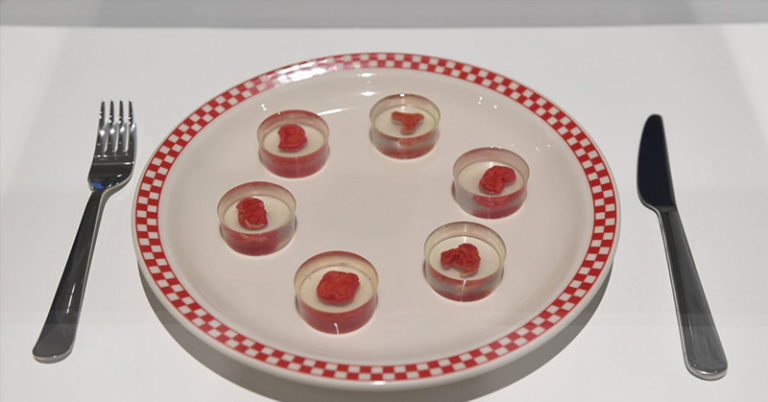Over the last several years, people have been looking for more sustainable alternatives to meat. Not everyone, however, is ready to give up meat entirely. For this reason, lab-grown “cruelty-free” meat has been gaining a lot of traction. Recently, some scientists decided to look beyond the hype and expose some of the emerging industry’s constraints. How? By growing their own human steaks.
Lab-Grown Meat: Is it Really Sustainable?
Over the last several years, the meat industry has come under fire for its cruel and unethical treatment of animals. This has prompted some scientists to ask the question: can we produce meat without killing animals?
Thus, the lab-grown meat industry came to be. Proponents of the industry say that it could eliminate many of the ethical issues with the way we currently produce meat. It could also reduce the environmental impact of animal farming [1].
In addition, some say that cultured meat products could satisfy the demand for food by our ever-increasing population [2].
Despite the fact that there are currently no lab-grown meats on the market, the industry is already worth several million dollars [1]. This, however, is referring to growing animal meats in the lab- not human steaks.
How Do You Grown Meat?
Before we dive into the idea of human steaks, let’s take a look at how scientists actually go about growing animal meat in a laboratory:
Step One: Get a muscle sample from an animal and collect the stem cells from the tissue.
Step Two: multiply them, then allow them to differentiate into primitive fibers. These then bulk up to form muscle tissue.
According to Mosa Meat, one of the manufacturers of lab-grown meats, one tissue sample from a cow can make eighty thousand quarter-pound burgers [1].
Human Steak
So where does human steak come into the picture, and more importantly- why?
The idea came from a group of American scientists who have developed an interesting concept: a grow-your-own steak kit. Instead of using animal tissues, however, you use human cells and blood.
They’re calling the concept The Ouroboros Steak, after the Egyptian snake that eats itself. The human cells will come from the inside of your cheek, and the blood comes from expired blood donations [3].
The scientists have already done this successfully, and the bite-sized pieces of human steak are currently on display at the Beazley Designs of the Year exhibition. But why would scientists want to create human steaks? Put simply, to make a point.
The lab-grown meat industry makes a lot of claims about being ethical and cruelty-free, but these scientists don’t fully agree with that statement. This is because the process still relies on fetal bovine serum (FBS), which comes from the blood of calf fetuses after their mothers are slaughtered. The industry uses it as a high-protein growth supplement for animal cell cultures.
Not only does the use of FBS still rely on the cruelty of the traditional meat industry, but it costs a lot of money. One liter of FBS costs between 350 and 830 dollars.
Andrew Pelling is one of the scientists who developed the human steak. He says that not only is FBS prohibitively expensive, it also doesn’t save the lives of animals.
“Although some lab-grown meat companies are claiming to have solved this problem, to our knowledge no independent, peer-reviewed, scientific studies have validated these claims,” he said [4].
Pelling, along with industrial designer Grace Knight and researcher Orkan Telhan, created this human steak to expose the underlying constraints of the lab-grown meat industry. Essentially, they wanted people to see beyond the hype.
Human Steaks- Is This Cannibalism?
The tiny steaks are currently on display at London’s Design Museum. The team has visions of DIY human steak kits, wherein people use a cotton swab to collect cells from the inside of their cheeks and place them on pre-grown scaffolds made of mushroom mycelium. They will then store it in a warm environment for three months, feeding it with human serum (aka blood) until it’s fully grown.
According to the researchers, if you were to eat one of these human steaks, it would not technically be cannibalism. That being said, they are not promoting that we “eat ourselves” as a solution to satisfying our protein needs. They designed the steak as more of a thought-provoking piece of art.
“We are not promoting ‘eating ourselves’ as a realistic solution that will fix humans’ protein needs,” the team said. “We rather ask a question: what would be the sacrifices we need to make to be able to keep consuming meat at the pace that we are? In the future, who will be able to afford animal meat and who may have no other option than culturing meat from themselves?” [4]
That being said, these human steaks are real, and they are edible. Whether or not you want to eat them? That is a separate question.
Sources
- ‘Lab-Grown Meat’ Scientific American G. Owen Schaefer. Published September 14, 2018
- ‘The Myth of Cultured Meat: A Review‘ Frontiersin Sghaier Chriki. Published February 7, 2020.
- ‘You can now eat human steak, scientists insist it’s not cannibalism’ Metro Alex Wilkins. Published November 18, 2020.
- ‘Ouroboros Steak grow-your-own human meat kit is “technically” not cannibalism’ Dezeen Jennifer Hahn. Published November 13, 2020

